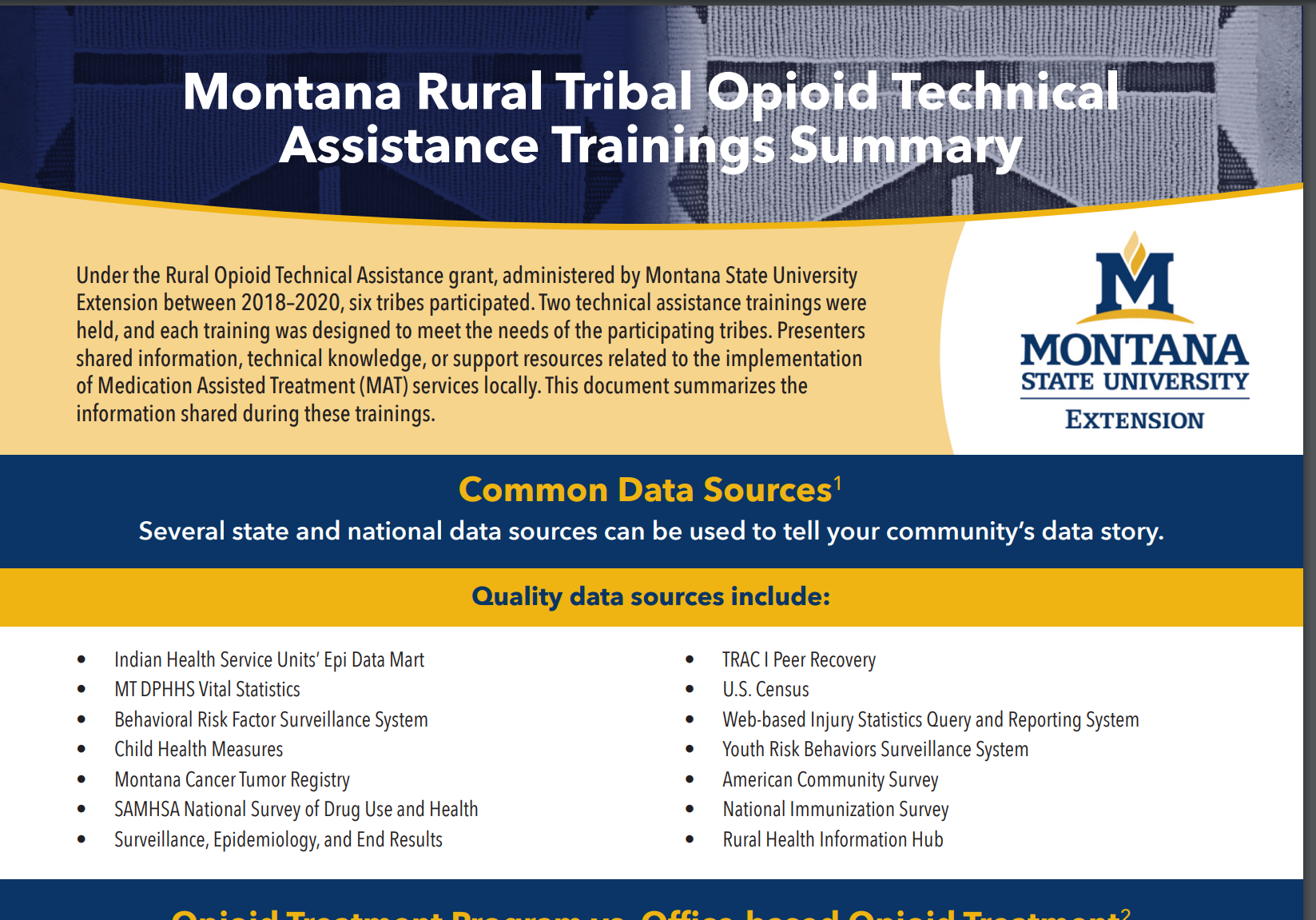Rural Opioid Tribal Technical Assistance Training Summary

View, print, or download Tribal Technical Assistance Training Summary
Tribal TA Summary
Under the Rural Opioid Technical Assistance grant, administered by Montana State University Extension between 2018–2020, six tribes participated. Two technical assistance trainings were held, and each training was designed to meet the needs of the participating tribes. Presenters shared information, technical knowledge, or support resources related to the implementation of Medication Assisted Treatment (MAT) services locally. This document summarizes the information shared during these trainings.
Common Data Sources:
Several state and national data sources can be used to tell your community’s data story.
Quality data sources include:
• TRAC I Peer Recovery
• U.S. Census
• Web-based Injury Statistics Query and Reporting System
• Youth Risk Behaviors Surveillance System
• American Community Survey
• National Immunization Survey
• Rural Health Information Hub
• Indian Health Service Units’ Epi Data Mart
• MT DPHHS Vital Statistics
• Behavioral Risk Factor Surveillance System
• Child Health Measures
• Montana Cancer Tumor Registry
• SAMHSA National Survey of Drug Use and Health
• Surveillance, Epidemiology, and End Results
Opioid Treatment Program vs. Office-based Opioid Treatment
Opioid Treatment Program (OTP) An outpatient program which provides comprehensive treatment services including pharmacological treatment for opioid use disorders.
• Program is licensed by the DEA to dispense Methadone, Suboxone (buprenorphine/naloxone), Subutex (buprenorphine), or Vivitrol (Naltrexone) - XR can be provided by prescription
• Can only dispense Methadone out of an OTP
• Methadone take homes are not allowed unless earned after several weeks of compliant program attendance with negative drug screens and compliance with the treatment plan developed with the patient and their counselor
• Patients initially go to the clinic 6 days a week for a nursing evaluation and observed dosing. Patients in the initial phase of treatment only take doses out of the clinic one day per week
• The clinic dispenses medication and a nurse observes its use
• Monthly counseling and medical provider appointments are required
• Accredited by SAMHSA/CARF to provide MAT with all FDAapproved medications
• No limit on number of patients who can be treated
• Medications dispensed are not reported to State Prescription Drug Monitoring Programs (PDMPs)
vs.
Office-based Opioid Treatment (OBOT) Substance use disorder treatment via primary care and general health care settings, and come specialty practices.
• Patients are seen by a medical provider with a DATA-waiver to prescribe Suboxone (buprenorphine/naloxone), Subutex (buprenorphine), or Vivitrol (Naltrexone)
•Prescriptions–patientfillsitattheirpharmacy
• Prescriptions are often written for a 28-day supply, and can have upto5refills
• No prescriptions for Methadone
• No federal requirement for counseling, but is recommended for improved outcomes
• Diversion calls are typically not done
•Waiveredprovidersarelimitedto30patientsintheirfirstyear,can apply for 100 patients in special circumstances, and can apply to see 275 patients after 2 years
Family Support Programs for OUD
• Family support programs are organized to build on community strengths and resilience, provide family support for relatives who are struggling, and provide education and support to family members.
•BenefitsoffamilysupportprogramsincreasefamilyknowledgeaboutOUD,increasethe family’s feeling of competence in helping their loved one, connects them with other families who have shared experiences, and reduces families’ sense of isolation.
• Technical assistance ideas for family support programs include family support for pregnant and post-partum women, web-based learning opportunities for family support training, telephone recovery check-ups, family support for youth using music and art, and integrated voices of family experiences in all aspects of OUD services.
Integration of Services for MAT
• MAT requires mental health services, addiction services, primaryhealthcare,pharmacy,police,otherfirstresponders,recovery supports, housing, and other wellness support
• Tribal-integrated services are a systems change, not a program change • Tribal leadership need to understand and support service integration
• Community input and review teams are important Integration of Services for MAT4 • Realistic, detailed steps for transition should be outlined in timeframes, resources, and goals
◆ One-stop and treatment protocols
◆ Examples of tribal organizational and operational changes
◆Examplesofclinicalworkflowassessmentandchanges
• Consistent communication on progress for staff and community are critical
Medication for Opioid Use Disorder: Stigma and Diversion
Fear of being “labeled” may be a barrier to accepting medication for opioid use disorder. There is a need for a paradigm shift that accepts harm reduction as being applicable to all chronic diseases, advocacy of substance use disorders as a chronic brain disease, genetic and epigenetic vulnerability, belief in science, and compassion. Words used by clinicians and staff make a big difference (e.g., saying a person whoinjectsdrugsvs.anaddict).AtooltoassistinnavigatingdifficultconversationsisVEMA–Validate,Educate, Motivate, and Activate. The following table offers examples for each step of the tool.6
Validate “It’s understandable that you are feeling upset by this discussion, and I believe your pain is real.”
Educate “I believe your pain is real, and we now know that taking opioid medications over time can lead to serious side effects. Are you interested in hearing more about that now?”
Motivate “What area in your life do you feel the most motivated to begin making lifestyle changes?”
Activate If starting taper treatment, “Which dose during the day would you like to start reducing first?”
REFERENCES
1 Rocky Mountain Tribal Leaders Council. (May 2019). Introduction to Research. [PowerPoint presentation]. Retrieved from http://health.msuextension.org/opioid_springtta_parkinglot.html
2 Schuler, R. (May 2019). An overview of OTP vs. OBOT and Community Medical Services. [PowerPoint presentation]. Retrieved from http://health.msuextension.org/opioid_springtta_parkinglot.html
3 Holly Echo-Hawk. (May 2019). Family Support Programs. [PowerPoint presentation]. Retrieved from http://health.msuextension.org/opioid_springtta_parkinglot.html
4 Holly Echo-Hawk. (May 2019). Integration of Services for MAT. [PowerPoint presentation]. Retrieved from http://health.msuextension.org/opioid_springtta_parkinglot.html
5 Daniel Nauts. (June 2020). Medication for Opioid Use Disorder: Stigma and Diversion. [PowerPoint presentation].
6 Oregon Pain Guidance. (May 2016). VEMA a tool for navigating difficult conversations. Retrieved from https://www.oregonpainguidance.org/wp-content/uploads/2017/11/vema-tool-for-navigating-difficult-conversations.pdf
